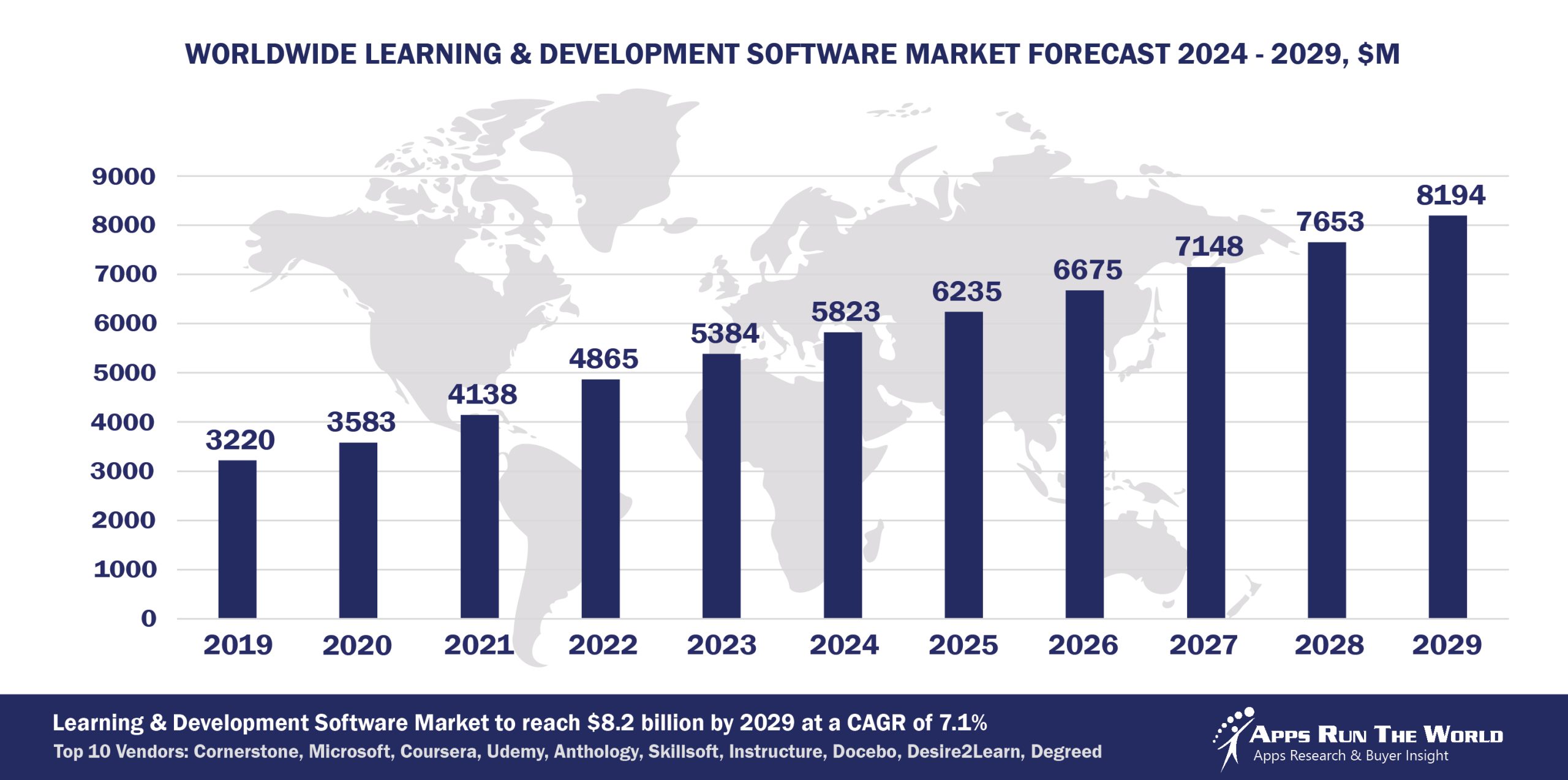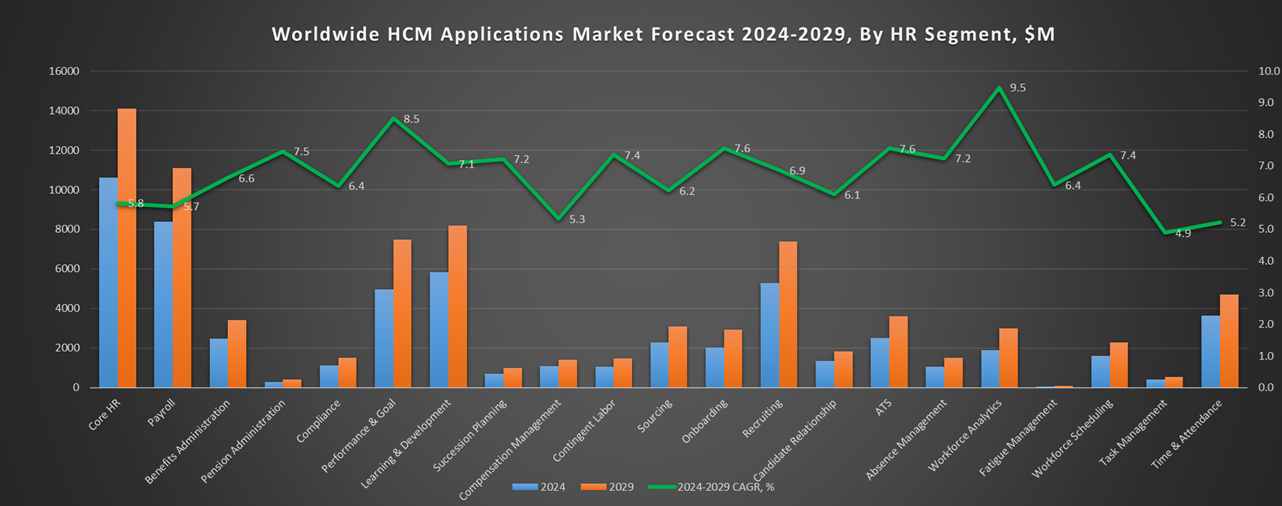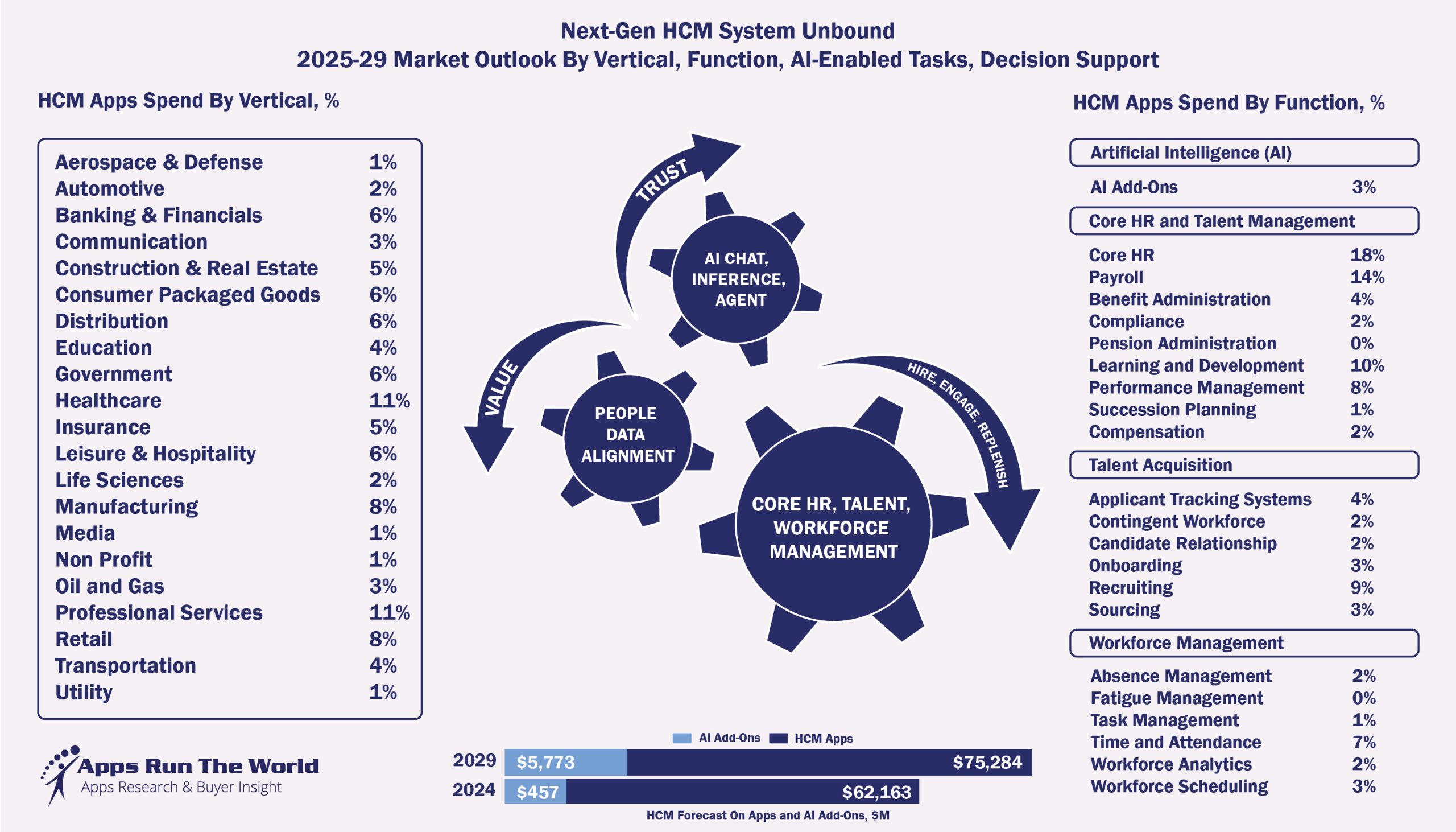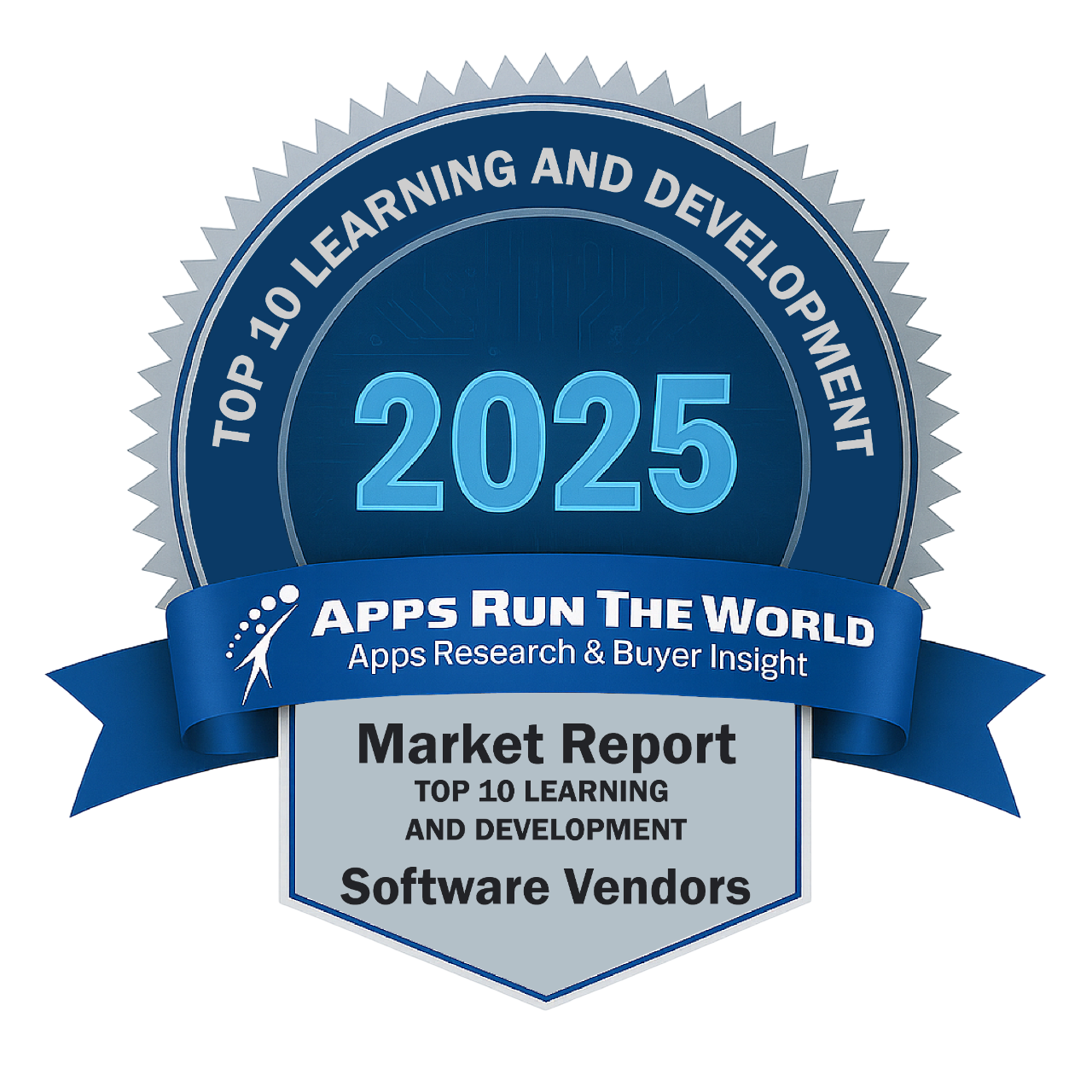
In 2024, the global Learning & Development marketgrew to 5.8 billion. marking an 8.2% year-over-year increase. The top 10 vendors accounted for 52.9% of the total market. Cornerstone OnDemand led the pack with a 11.3% market share, followed by Microsoft, Coursera, and Udemy.
Through our forecast period, the Learning & Development applications market size is expected to reach $8.2 billion by 2029, compared with $5.8 billion in 2024 at a CAGR of 7.1%, as shown in the Apps Top 500 Report – Excel Edition [Preview] .
Top 10 Learning & Development Software Vendors in 2024 and their Market Shares
Source: Apps Run The World, July 2025
Other Learning and Development software providers included in the report are: 360Learning, 2U, INC., Absorb Software, Axonify, ADP, Advanced, Articulate, BetterUp, BizLibrary, BLR Compliance, Blackbaud, CareerBuilder, CatalystOne Solutions, CrossKnowledge, Cegid, Dayforce, Constellation Software Inc., Degreed, Desire2Learn, Deskera, Dominknow, Easygenerator, Edmentum, Ellucian, ELMO Software, Epicor, Exela Technologies, Flipick, Follett School Solutions, Frontier Software, Gloat, Go1, Haufe, HealthStream, Hilan, Imagine Learning, iSpring Solutions, Infinite Campus, Infor, isolved, Jenzabar, Kingdee, KNOLSKAPE, Kahoot, LG lugar de gente, TELUS Health (including LifeWorks ), LearningMate, Meridian Knowledge Solutions, NEOGOV, Oracle, Paychex, Paycor, Paylocity, Pluralsight, Paradiso Solutions, PowerSchool Group, Reflection Software, Roper Technologies, Renaissance Learning, SD Worx, Savvas, ServiceNow, Seismic Software, Rival (formerly SilkRoad Technology), Symphony Talent, Talentia Software, TalentQuest, Toba HR Solutions, a Tobania Company, Training Orchestra, UNIT4, UKG, Visma, Workday, Workhuman, Yardi, Zoho Corp., Zywave, and others.
Vendor Snapshot: Learning and Development Market Leaders
 Cornerstone OnDemand
Cornerstone OnDemand
Cornerstone’s integrated learning ecosystem—including Cornerstone Learn, SumTotal, and Saba—has evolved with AI-native capabilities under its Galaxy AI framework, including generative content creation, skill intelligence, and immersive role-based coaching via Immerse Companion. Its 2024 acquisitions of SkyHive (skills data) and TaleSpin (XR learning) expand predictive workforce planning and immersive learning, transforming L&D into a strategy-driven, skills-first experience.
Microsoft
LinkedIn Learning, a part of Microsoft—has embedded AI-powered features such as conversational Learning Coach, role-play simulations, AI-assisted search, and personalized Learning Plans aligned with over 150 AI Skill Pathways.
Coursera
Coursera’s enterprise learning platform expanded its AI-driven capabilities with Coursera Coach, an AI tutor that supports personalized feedback, content summarization, and learning guidance across over 36 million interactions.
Udemy
Udemy’s enterprise platform continues to expand its AI-powered learning features, including the Udemy AI Assistant for real-time guidance, Skills Mapping for automated learning pathways, and Role Play, launched in May 2025, to simulate soft-skills practice at scale. These tools aim to personalize the learning experience and enhance engagement through generative AI.
Anthology (Blackboard, Campus Management, Campus Labs, and iModules)
Anthology’s Blackboard LMS, part of its broader Learn and Engage product ecosystem, has embedded generative AI tools—such as the AI Design Assistant, AI Conversations, and the Anthology Virtual Assistant (AVA)—to aid instructors, streamline content creation, and support student engagement with real-time responses and feedback generation.
Skillsoft
Skillsoft’s Percipio platform integrates AI-powered tools to automate learning personalization, enhance search relevance, and curate role-based career paths. Features such as an AI Assistant for Smart Content Discovery, an AI Coaching Guide for ongoing learner support, and a coding assistant (via Codecademy integration) provide tailored feedback, real-time learning recommendations, and practical programming guidance throughout the learning journey.
Instructure, Inc.
Instructure’s Canvas LMS and Mastery platform have introduced AI-augmented capabilities such as Intelligent Insights (featuring an “Ask Your Data” conversational AI interface) and IgniteAI-powered assessment tools, enhancing content generation, student support, and data-driven decision-making. A July 2025 partnership with OpenAI enables educators to create LLM-Enabled Assignments within Canvas, while the acquisition of Parchment in 2024 supports expanded credentialing and skills-based learning offerings.
Docebo
Docebo’s AI-first learning platform has expanded significantly following its 2023 acquisition of Edugo.AI, integrating generative AI-powered tools like AI Creator and AI Video Presenter to automate content authoring and immersive video production. The 2025 release unveiled AI Virtual Coaching, Harmony (an agentic marketplace and co-pilot for L&D workflows), AI Neural Search, and Virtual Labs, enabling natural-language interaction, scenario-based simulations, and experiential training within a redesigned, intelligence-first UX.
Desire2Learn
D2L’s Brightspace LMS recently incorporated generative AI across its Lumi suite to enhance instructor workflows and learner support. New features include Lumi Chat for contextual help, Lumi Tutor as an embedded cognitive coach, Lumi Feedback for automatic grading assistance, and Lumi Study Support with personalized learning recommendations based on quiz performance. Additional AI-driven capabilities like Lumi Questions (automatic question generation) and AI-powered course content generation (from files) streamline content creation and assessment authoring, aligning with broader trends in adaptive, efficient learning platforms.
Degreed
Degreed’s learning platform has evolved into an AI-native workforce solution with features like Maestro Studio and Open Library, enabling automated pathway creation, skills coaching, and adaptive learning experiences. The platform acts as a skill intelligence system, generating personalized recommendations, role-based simulations, and AI-powered content interactions—aligned with enterprise L&D demands for upskilling and internal mobility.
ARTW Technographics Platform: Learning and Development customer wins
Since 2010, our research team has been studying the patterns of Learning and Development software purchases, analyzing customer behavior and vendor performance through continuous win/loss analysis. Updated quarterly, the ARTW Technographics Platform provides deep insights into thousands of Learning and Development customer wins and losses, helping users monitor competitive shifts, evaluate vendor momentum, and make informed go-to-market decisions.
List of Learning and Development customers
Source: ARTW Buyer Insights Technographic Database
Custom data cuts related to the Learning and Development Applications market are available:
- Top 350+ Learning and Development Applications Vendors and Market Forecast 2024-2029
- 2024 Learning and Development Applications Market By Vertical Market (21 Industry)
- 2024 Learning and Development Applications Market By Country (USA + 45 countries)
- 2024 Learning and Development Applications Market By Region (Americas, EMEA, APAC)
- 2024 Learning and Development Applications Market By Revenue Type (License, Services, Hardware, Support and Maintenance, Cloud)
- 2024 Learning and Development Applications Market By Customer Size (revenue, employee count, asset)
- 2024 Learning and Development Applications Market By Channel (Direct vs Indirect)
- 2024 Learning and Development Applications Market By Product
Through our forecast period, the HCM applications market is expected to reach $81.1 billion by 2029, compared with $58.7 billion in 2024 at a compound annual growth rate of 11.7%.
Through our forecast period, the Core HR and Talent Management applications market, which is comprised of nine subsegments, is expected to reach $48.6 billion by 2029, compared with $35.5 billion in 2024 expanding at a compound annual growth rate of 11.6%. For the Top 10 vendors in each of the nine subsegments, please check their own index page by following the link below.
Through our forecast period, the Talent Acquisition applications market, which is comprised of six subsegments, is expected to reach $20.3 billion by 2029, compared with $14.5 billion in 2024 expanding at a compound annual growth rate of 11.7%. For the Top 10 vendors in each of the six subsegments, please check their own index page by following the link below.
Through our forecast period, the Workforce Management applications market, which is comprised of six subsegments, is expected to reach $12.1 billion by 2029, compared with $8.7 billion in 2024 expanding at a compound annual growth rate of 12.1%. For the Top 10 vendors in each of the six subsegments, please check their own index page by following the link below.
Our HCM Top 500 research team also tracks Time Clock Hardware vendors separately by zeroing in on their embedded software as well as their extensive use of OEM and distribution partners.
Exhibit 3: Worldwide HCM Software Market 2024-2029 Forecast, $M
Source: Apps Run The World, July 2025
Exhibit 4 shows our projections for the HCM enterprise applications market by HCM sub-segment, based on the buying preferences and the customer propensity to invest in new software within those industries as they continue to upgrade and replace many legacy industry-specific applications that have been identified and tracked in our Buyer Insight Database.

FAQ – APPS RUN THE WORLD Top 10 Learning & Development Software Vendors, Market Size & Forecast
Q1. What is the global Learning & Development software market size in 2024?
A: The global Learning & Development software market reached $5.8 billion in 2024, growing 8.2% year-over-year.
Q2. Who are the top 10 Learning & Development software vendors in 2024 and their combined share?
A: The top 10 vendors in 2024 are Cornerstone OnDemand, Microsoft, Coursera, Udemy, Anthology (Blackboard, Campus Management, Campus Labs, and iModules), Skillsoft, Instructure (Canvas), Docebo, Desire2Learn (D2L), and Degreed, collectively accounting for 52.9% of the global Learning & Development software market.
Q3. Which vendor leads the Learning & Development software market in 2024?
A: Cornerstone OnDemand leads the Learning & Development software market in 2024 with an 11.3% market share.
Q4. How does this report define the Learning & Development software market scope?
A: The Learning & Development software market includes solutions for learning management systems (LMS), content creation, skill development, compliance training, and performance support.
Q5. What is the Learning & Development software market outlook through 2029?
A: The Learning & Development software market is projected to grow to $8.2 billion by 2029, at a 7.1% compound annual growth rate.
Q6. Which other Learning & Development software vendors are covered beyond the top 10?
A: The report also profiles vendors such as SAP Litmos, Pluralsight, and LinkedIn Learning, among others, offering learning and development solutions.
Q7. When was this report published and by whom?
A: The Top 10 Learning & Development Software Vendors, Market Size and Forecast 2024–2029 was published July 29, 2025, by APPS RUN THE WORLD analysts Albert Pang, Misho Markovski, and Milena Kostadinovski, as part of the APPS TOP 500 research program, which benchmarks the revenues and market share of the world’s 1,500+ largest enterprise application vendors.
Methodology
Similar to any of the hundreds of reports that we have published since 2010, HCM Top 500 is a labor of love. Since 2013, our team of researchers have been conducting rigorous research on thousands of HCM vendors, surveying them quarterly, reviewing their products at even shorter intervals because of the compressed Cloud release cycle, and discussing HR vision with their customers to better understand user needs as well as different paths to upgrade and replace their existing systems.
Each year we also attend many industry-wide and vendor-specific user conferences – HR Tech, Dreamforce, SAPPHIRENOW, Oracle Open World, just to name a few, to gauge what customers are looking for.
Throughout this process comes a rich database of more than 2,000 HCM vendors as well as over 50,000 HCM customers that have been touched one form or another through regular surveys, phone and in-person interviews, email exchanges, and social media interactions, etc.
On a proactively basis, we contact the vendors directly to tabulate their latest quarterly and annual revenues by HCM segment, vertical market, revenue type, region, country and customer size.
We supplement their written responses with our own primary research to determine quarterly and yearly growth rates in each of the 22 segments and 21 verticals, in addition to customer wins to ascertain whether these are net new purchases or expansions of existing implementations.
Another dimension of our quantitative research process is through continuous improvement of our customer database, which stores more than one million records on the enterprise software landscape of over 100,000 organizations around the world.
The database provides customer insight and contextual information on what types of HCM, enterprise software systems and other relevant technologies they are running and their propensity to invest further with their current or new suppliers as part of their overall HCM and IT transformation projects to stay competitive, fend off threats from disruptive forces, or comply with internal mandates to improve overall enterprise efficiency.
The result is a combination of supply-side data and demand-generation customer insight that allows our clients to better position themselves in anticipation of the next wave that will reshape the HCM marketplace for years to come.
HCM Market Taxonomy

Definition of Human Capital Management (HCM) Applications
Core HR and Performance Management
| Core HR and Performance Management | Description |
|---|---|
| Personnel and Organization Management | Core human resource management system, personnel records, HR master file, accruals, organizational development, org chart visualization |
| Payroll | Payroll processing, tax filing, language support, country-level updates, payslip calculations, automatic deductions and other government requirements for proper disbursement of employee compensation. |
| Benefits Administration | Benefits and health administration. Plan and design benefits lifecycle, billing and payment. Carrier solutions are also included for integration purposes. |
| Pension Administration | Pension and retirement fund(401K) administration as well as software that helps manage profit sharing plan, defined benefit plan, or cash balance plan. |
| Compliance | Compliance, regulatory updates and reporting including such laws as Affordable Care Act, Overtime Regulations, Fair Labor Standards Act |
| Performance and Goal Management | HR performance management applications are designed to automate the aggregation and delivery of information pertinent to the linking of job roles and the mission and goals of the organization. More specifically, the system allows users to automate the performance review process by using mechanisms such as training and key performance indicators to continuously track and monitor the progress of an individual employee, work team, and division. Some of the key features include: Assessment of individual career objectives and organizational skills gaps that impede performance and job advancement. Continuous reviews and establishing milestones. 360-degree evaluation and real-time feedback. Performance appraisal automation. Goal setting and tracking. Employee surveys. Alignment of human assets to corporate objectives. Fast tracks for top performers. |
| Learning and Development | Learning management systems refer to applications that automate the administration, tracking, and reporting of training events. Other tools may include courseware and other delivery, management, tracking, or integrated solutions whose focus is on the learning environment, including learning content management systems. Career development tools include apps for coaching, mentoring, employee development planning, and diagnosing of development needs. |
| Succession and Leadership Planning | Identify and address current and potential talent gaps to create succession management reporting. Develop and maintain a continuous supply of internal talent to fill critical job roles. Improve employee engagement through digital tools to advance career path development opportunities. |
| Compensation Management | Compensation management applications are designed to automate the process of providing cash, noncash, variable and nonvariable compensation to employees through advanced modeling, reporting, and built-in interfacing to payroll processing systems. Other key features include seamlessly manage compensation budgets and allocation in a single, shared tool. Streamline pay recommendation workflows and approvals. Support multiple pay and incentive practices. Ensure budget compliance and adherence to compensation guidelines. Quota and territory management. Calculation and distribution of commissions, spiffs, royalties, incentives to employees, and channel and business partners. Compensation analysis using internal and external data for retention risk analysis. Linking salary, commission and incentives — cash and noncash — to business objectives. Payroll and payment engine interfaces. Account payables integration. |
Talent Acquisition
| Talent Acquisition | Description |
|---|---|
| Applicant Tracking | Applicant tracking software automates such functions as management of resumes, applicant information, scoring, workflow, matching, search, interview scheduling, job descriptions, EEOC reporting, job postings and notifications |
| Recruiting | Recruiting applications are designed to automate the recruitment process of salaried and hourly employees through screening and skills assessment, as well as automated selection processes to improve hiring pipeline by identifying talent inside or outside the organization. Other key features include: Manage skills inventories. Create and manage job requisitions. Coordinate team collaboration within hiring processes. Video Interviewing, team building and digital coaching. |
| Candidate Relationship Management | Applications designed to attract and engage candidates and employees. Other tasks automate functions such as candidate relationship management apps, career site technology, social recruiting, employee referrals, branding, video engagement, campus recruiting and internal hiring |
| Contingent Labor Management | Processing of hiring of contingent labor, search, skills matching, assessment, interview scheduling, negotiation of rates, approvals, project milestone payments, project completion tracking, performance ratings |
| Sourcing | Facilitate resource planning for staffing firms as well as vendor managed system, allowing for front office integration for employment agencies as well as talent acquisition apps designed for staffing firms. |
| Onboarding | Applications designed to deploy workers to appropriate jobs, projects, or teams for accelerated on-boarding. |
Workforce Management
| Workforce Management | Description |
|---|---|
| Absence and Leave Management | Absence management applications offer automated features to support employee leave management, employer authorized leave, Short-Term-Disability/Workers’ Comp coordination, federal and state compliance, customized leave correspondence, medical certification processing, insurance premium payment tracking as well as employee self-service capabilities. Leave Management supports compliance activities related to government regulations such as the Family and Medical Leave Act in the United States and other local leave laws in different countries. |
| Workforce analytics | Workforce analytics are used to analyze compensation, benefits, and other employee variables. These applications can also be used to analyze and optimize labor allocation for particular projects. |
| Fatigue Management | Fatigue Management apps help automate key facets of fatigue risk mitigation, enforcing employee work-hour limits and aligning with fitness for duty best practices. Similar apps may act as electronic work diaries for real-time reporting and compliance with transportation laws. |
| Hardware (Time Clock) | Time capture is the hardware platform that provides authentication features for clock-in and clock-out times, meal and rest breaks, as well as timesheet and payroll reporting and compliance. |
| Scheduling | Products are designed to Increase forecasting accuracy by factoring in a variety of methods and historical patterns. Create optimal schedules to meet customer demands, while reducing costs and maximizing resources |
| Task Management | Task Management offers labor management capabilities such as task-based and project-based activity tracking as well as measurement and reporting functions against performance standards like engineered labor standards, team standards and reflective standards. |
| Time & Attendance | Time and Attendance applications are designed to automate employee time tracking in different locations, help reduce overtime expenses, improve payroll accuracy, eliminate pay errors and adjustments, along with the need to simplify and optimize administrative tasks and complex rate calculations by making available accurate and current labor data and full audit trail of payroll data. |
- SAP, a Germany based Professional Services organization with 109973 Employees
- Sumtotal Systems, LLC, a United States based Professional Services company with 1200 Employees
- Administrate, a United States based Professional Services organization with 180 Employees
| Logo | Company | Industry | Employees | Revenue | Country | Evaluated |
|---|


 Cornerstone OnDemand
Cornerstone OnDemand